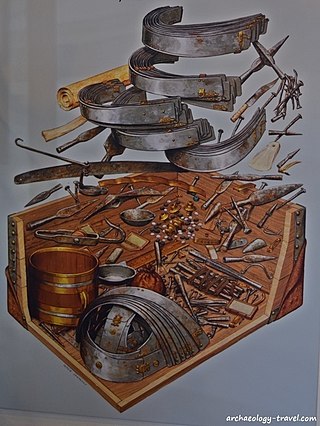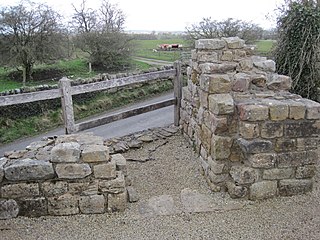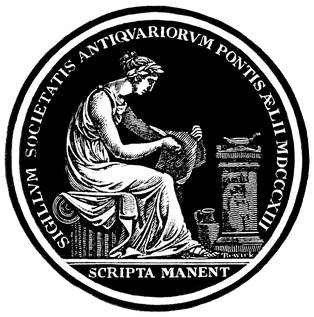
Coventina was a Romano-British goddess of wells and springs. She is known from multiple inscriptions at one site in Northumberland, England, an area surrounding a wellspring near Carrawburgh on Hadrian's Wall. It is possible that other inscriptions, two from Hispania and one from Narbonensis, refer to Coventina, but this is disputed.
Below are notable events in archaeology that occurred in 1876.

The Museum of Antiquities was an archaeological museum at the University of Newcastle upon Tyne, England. It opened in 1960 and in 2009 its collections were merged into the Great North Museum: Hancock.

Arbeia was a large Roman fort in South Shields, Tyne & Wear, England, now ruined, and which has been partially reconstructed. It was first excavated in the 1870s. All modern buildings on the site were cleared in the 1970s. It is managed by Tyne and Wear Museums as Arbeia Roman Fort and Museum.

Cilurnum or Cilurvum was an ancient Roman fort on Hadrian's Wall at Chesters near the village of Walwick, Northumberland. It is also known as Walwick Chesters to distinguish it from Great Chesters fort and Halton Chesters.

The Corbridge Hoard is a hoard of mostly iron artefacts that was excavated in 1964 within the Roman site of Coria, next to what is now Corbridge, Northumberland, England.

Coria was a fort and town 2.5 miles (4.0 km) south of Hadrian's Wall, in the Roman province of Britannia. It was strategically located on the junction of a major Roman north–south road with the River Tyne and the Roman Stanegate road, which was also the first frontier line which ran east–west between Coria and Luguvalium. Corbridge Roman Site is in the village of Corbridge in the county of Northumberland.

Carrawburgh is a settlement in Northumberland. In Roman times, it was the site of a 3+1⁄2-acre (1.5 ha) auxiliary fort on Hadrian's Wall called Brocolitia, Procolita, or Brocolita.

Milecastle 0 is a possible milecastle of the Roman Hadrian's Wall which may have preexisted the fort of Segedunum. Although its existence has been suggested by historian Peter Hill, no evidence of this milecastle has been found. It is not known whether the decision to establish forts on the line of the wall predated the decision to extend the wall to Wallsend, so it is possible that this milecastle was never built.

Longhorsley is a village in Northumberland, England about 7 miles (11 km) northwest of Morpeth, and about 14 miles (23 km) south of Alnwick. The A697 road passes through the village linking it with Morpeth, Wooler and Coldstream in Scotland. There are 8 "Streets" in Longhorsley: Whitegates, Church View, Drummonds Close, South Road, West Road, East Road and Reivers Gate, Wilding Place and .The village is bordered on the north by the River Coquet. The village formerly lay in three separate townships: Bigges Quarter, Freeholders Quarter and Riddells Quarter.

Milecastle 7 (Benwell Bank or Benwell Hill) was a milecastle of the Roman Hadrian's Wall. The milecastle itself has not been discovered by archaeologists and its presumed location lies beneath a modern housing development. Roman finds have been made in the area and the associated structure of Turret 7B is a significant surviving structure of the wall.

Pike Hill Signal Tower was one of a number of signal stations that were built on high ground overlooking the line of the Roman Stanegate road in northern Britannia during the early 2nd century. It later became incorporated into Hadrian's Wall. Its remains, a 2-metre long fragment of the south-east wall, lie south of a modern road cutting and field wall, located in the parish of Waterhead in Cumberland, United Kingdom. The tower is located between Turret 51B and Turret 52A with the fort of Banna located to the east.

The Society of Antiquaries of Newcastle upon Tyne, the oldest provincial antiquarian society in England, was founded in 1813. It is a registered charity under English law.

Brian Dobson was an English archaeologist, teacher and scholar. His specialisms were Hadrian's Wall and the Roman Army. He studied under Eric Birley and is a member of the so-called 'Durham School' of archaeology. He was a Reader Emeritus of Durham University.
David John Breeze, OBE, FSA, FRSE, HonFSAScot, Hon MIFA is a British archaeologist, teacher and scholar of Hadrian's Wall, the Antonine Wall and the Roman army. He studied under Eric Birley and is a member of the so-called "Durham School" of archaeology. He was a close friend and colleague of the late Dr Brian Dobson.
Henry Russell Robinson was a British military armourer and historian.

Alexandra T. Croom BA is a British archaeologist and museum curator.
Nina Crummy is a British archaeologist and artefact specialist, especially of Roman material culture.
Quita Mould is an archaeologist, specialising in small finds and the identification of leather.
Paul Thomas Bidwell was a British archaeologist specialising in Roman Britain, Roman pottery, Hadrian's Wall and the Roman army in Britain.














